Outrigger Canoe History As Of 2020-December-15
Timeline
The following table contains an approximate timeline of the history of outrigger canoes from the Malia in the 1930’s through to the Unlimited OC6s in recent years. The chronology of these events is based on details as per the Evolution of the Modern Racing Canoes in California and the Evolution of the Modern Racing Canoe documents found in the Southern California Outrigger Racing (SCORA) archives.
Each chapter of the chronicle is based on details contained within the web articles referenced in the chapter or from interviews conducted with individuals mentioned in the chapter. Much of this history is from many years in the past and reference material will become increasingly more difficult to locate as time goes on. Some of the web articles have been saved as documents to preserve the reference material in event the original article becomes lost forever.
| # | Designer Builder | Make | Timeline | Reference |
|---|---|---|---|---|
| CH-01 | James Takeo Yamasaki | Malia (wooden) | 1933-1959 | 01-Yamasaki |
| CH-02 | Tom Johnson / Noah Kalama | Malia (fiberglass) | 1959-1978 | 02-Malia |
| CH-03 | Tommy Conner / Joe Quigg | Manu Ula | 1976-1977 | 03-ManuUla |
| CH-04 | Dennis Campbell (Imua) | Rail / Rhino | 1980 | 04-Rhino |
| CH-05 | Joe Quigg / Walter Guild | Hawaiian Class Racer (HCR) | 1982 | 05-HCR |
| CH-06 | Force Marine | Jim Patterson | 1983 | 06-Patterson |
| CH-07 | Joe Quigg | Kaoloa | 1986 | 07-Kaoloa |
| CH-08 | Sonny Kaukini Bradley | Bradley Racer | 1987 | 08-Racer |
| CH-09 | David Boulding / Jim Mancell | Malia (Canada) | 1988-1989 | 09-Expo 86 |
| CH-10 | Bob Disbrow / Don Mulhall | Hawaiian Class Racer (HCR) | 1988-1989 | 10-HCR Canada |
| CH-11 | Joe Quigg | Channel Master Ama | 1989 | 11-WiliWili |
| CH-12 | Ron Kaschula (Calmar Fiberglass) | Canadian Class Racer (CCR) | 1990-2007 | 12-Calmar |
| CH-13 | Dennis Campbell (Imua) | Pacific Islander | 1991 | 13-Brazil |
| CH-14 | Edward Maamaatua | IPCF OC6 hull | 1992 | 14-Natoma IPCF |
| CH-15 | Walter Guild | Force Five | 1995-1999 | 15-Force 5 |
| CH-16 | Sonny Kaukini Bradley | Bradley Encore | 1996 | 16-Encore |
| CH-17 | Greg Barton | Clipper Advantage | 1998-2020 | 17-Advantage |
| CH-18 | James Van Nostrand | Clipper North Beach (OC4) | 1998-2011 | 18-Nostrand |
| CH-19 | Korovu Vakaloloma | Fijian (Rotuman) Tafaga | 1998-1999 | 19-Fiji IVF |
| CH-20 | Sonny Kaukini Bradley / Calvin Hirahara | Bradley Striker | 1999 | 20-Striker |
| CH-21 | Karel Tresnak | Outrigger Connection Mirage | 2000 | 21-Mirage |
| CH-22 | Jude Turczynski | Huki OC6 Amas | 2003 | 22-Huki |
| CH-23 | Sonny Kaukini Bradley | Bradley Lightning | 2005 | 23-Lightning |
| CH-24 | Karel Tresnak | Outrigger Connection Mirage M2 | 2008 | 24-M2 |
| CH-25 | Kamanu Composites (Woo) | Kamanu V6 | 2010 | 25-Kamanu |
| CH-26 | Pogue Sports | Bradley Lightning (New Caledonia) | 2009-2010 | 26-Noumea IVF |
| CH-27 | Pogue Sports | Bradley Lightning (Canada) | 2010-2013 | 27-Calgary IVF |
| CH-28 | ARE Va’a Tahiti | Matahina | 2012 | 28-Matahina |
| CH-29 | Mike Giblin | Vortex | 2012 | 29-Vortex |
| CH-30 | Johnny Puakea | Malolo | 2013 | 30-Malolo |
| CH-31 | IHE Steve Blyth | Vantage 6 | 2017 | 31-IHE |
Chronicle
[CH-01-Yamasaki]
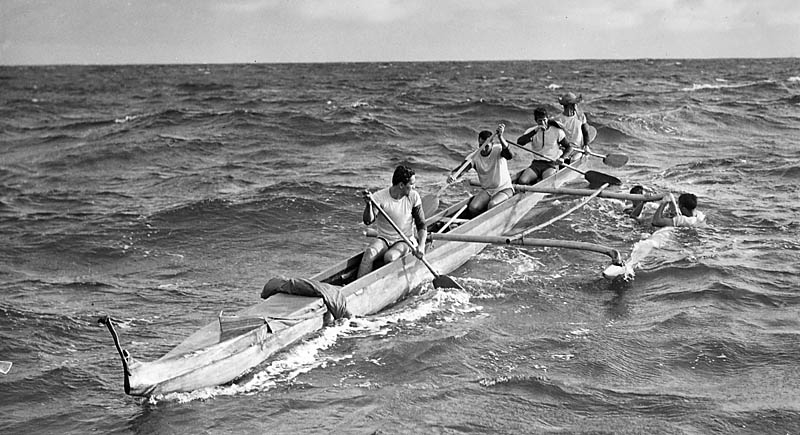
Kahuna kalai wa’a (master canoe carver) James Takeo Yamasaki was a craftsman finisher and all-around carpenter who lived and worked on the Kona Coast of the Big Island of Hawaii. George David “Dad” Center had been a member of the Outrigger Canoe Club (OCC) since 1908 and was an employee of Theo H. Davies sent to oversee the takeover for indebtedness of a company named Takemoto Hardwoods in the business of cutting koa for sale in 1934. “Dad” Center found three koa canoes that had been roughed out by the canoe builders at Takemoto. The 39’2″ canoe that would become the founding model for subsequent outrigger racing canoeing hulls and eventually named the Malia was first felled and hewn from blonde koa wood in 1933. The two sister canoes would later be named Leilani and Kakina. “Dad” Center hired James Takeo Yamasaki in February 1936 to shape the three koa canoes. The finished canoes were shipped to Waikiki and raced for the first time in Honolulu Harbor in June 1936.
Return To Timeline[CH-02-Malia]
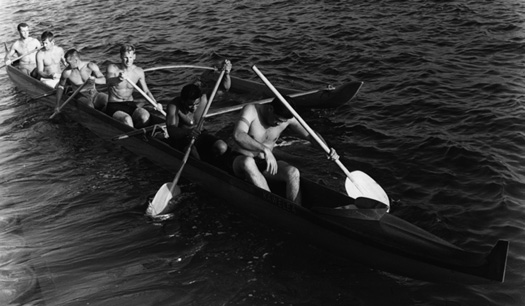
Albert Edward “Toots” Minvielle founded the first Moloka‘i to O‘ahu race in 1952. The Malia had been lengthened to 39’6″ in 1950. The Malia won Moloka‘i to O‘ahu races in 1953, 1958 to 1963. Toots Minvielle initiated efforts to conduct the first outrigger race on the mainland by sending three koa canoes (Malia, Niuhi, and a training canoe) and Noah Kalama to the Newport Dunes to coach a California team in the summer of 1959. This first long-distance race from Catalina Island to the Newport Dunes took place on September 20, 1959. However, there was an alleged pirating of the Malia a few days before shipment back to Honolulu. Tom Johnson, Noah Kalama, and some helpers made a fiberglass mould using the Malia as the plug. Fiberglass canoes in use around the world for decades have been made from this first fiberglass mould and other moulds that were made.
Return To Timeline[CH-03-Manu Ula]
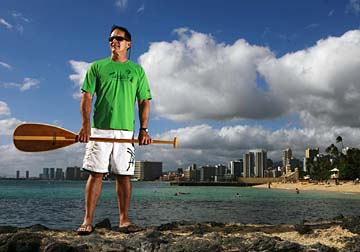
The Tahitians came with nine crews to Hawaii in 1976 with their long, narrow, sleek fiberglass canoes to race in the Moloka`i to Oahu race winning not only first place but also taking eight of the top 11 places. The original Manu Ula was built in 1977 to 43 feet in length by OCC member Tommy Conner as a response to the fast canoe the Tahitians had used in winning the Molokai Hoe the preceding year and then reduced to 38 feet (the first of many modifications to comply with HCRA’s ever-changing rules defining what constitutes a Hawaiian racing canoe) was the first fiberglass racing canoe used by the OCC. The Manu Ula won the Molokai Hoe in 1977 and 1979. Outrigger Canoe Club (OCC) asked Joe Quigg in 1981 to completely remodel the original fiberglass canoe Mana Ula, up to the maximum limits of 44 feet as per the new HCRA rules.
Return To Timeline[CH-04-Rhino]
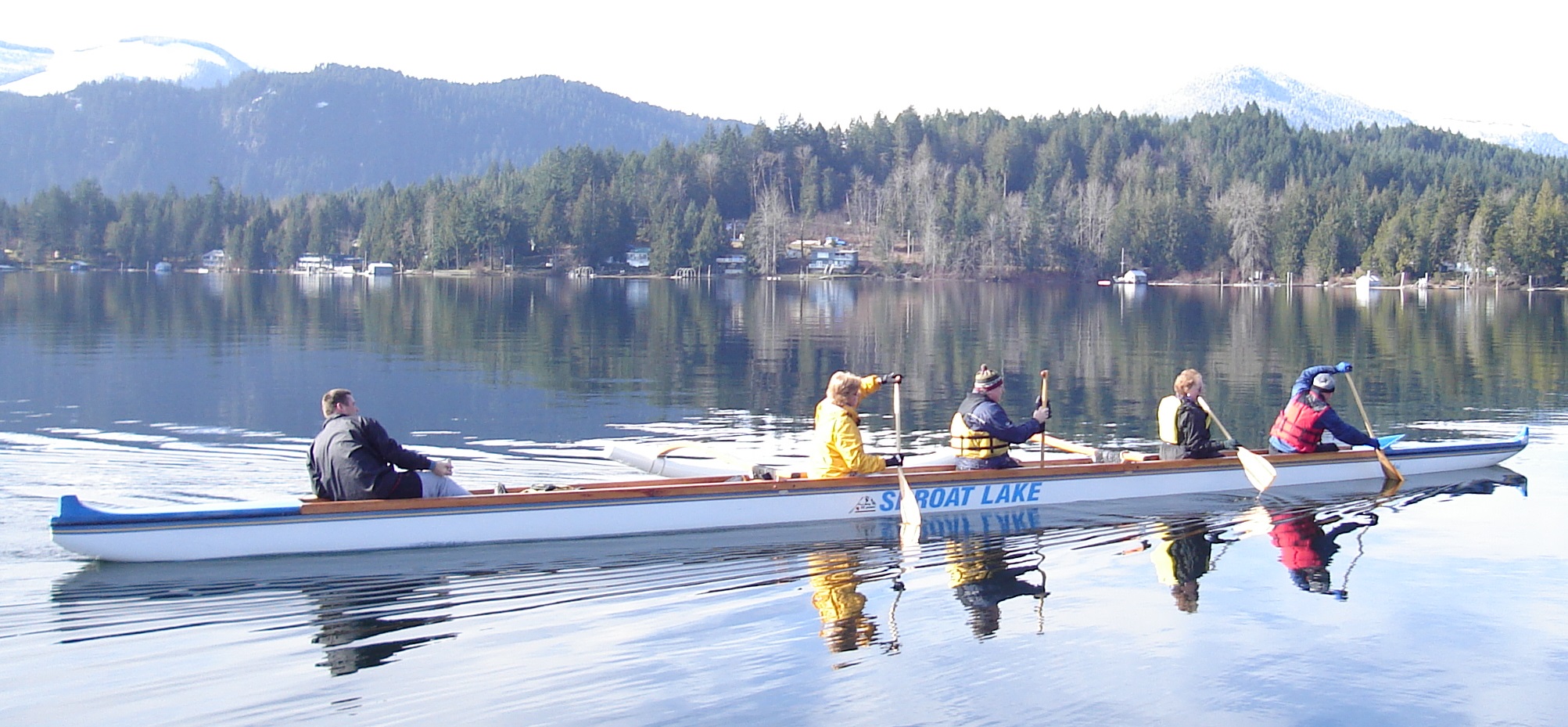
Dennis Campbell is a legendary paddler coach canoe designer from Imua Outrigger Club in Southern California. During the 1980’s and 1990’s he designed manufactured a line of canoes (Rail; Rhino; Pacific Islander) that were suited to the calmer waters along the Southern California coastline vs. Hawaiian style canoes that performed best under rough water conditions.
There are presently 2 Dennis Campbell Rhino OC6s at a single CORA club (Prince Rupert). Two Dennis Campbell Rhino OC6s found their way to Canada sometime around 1999. One went to Victoria and the other went to Penticton. The Rhino in Victoria made its way to Sproat Lake sometime in 2003. The Rhino at Sproat Lake and the Rhino at Penticton were loaded onto a flatbed truck sometime in 2009 and they were last seen on the Cow Bay Marina floating dock in Prince Rupert. Up until Sproat Lake provided details of their Rhino, the only photo of a Dennis Campbell Rhino was of the Outrigger Santa Cruz (OSC) Maka Nui.
[CH-05-HCR]
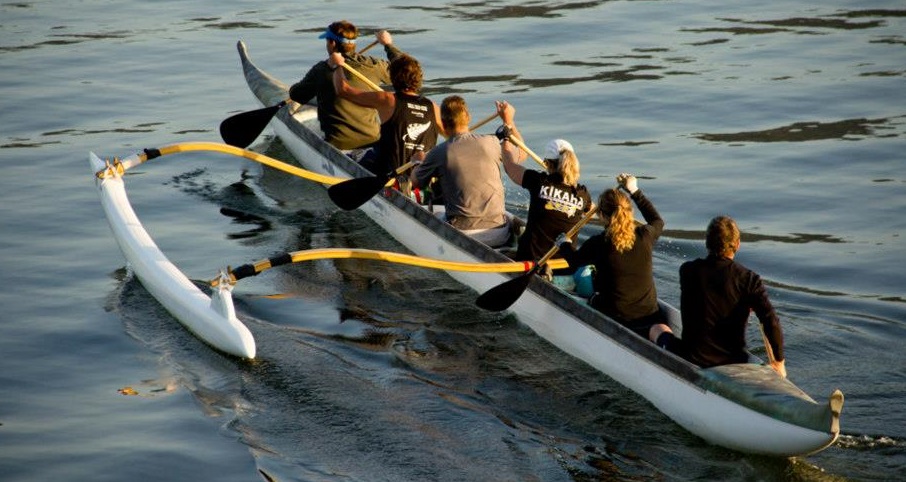
Joe Quigg has a long career as a designer and builder of surfboards, racing paddleboards, one-man canoes, catamarans, and Hawaiian racing canoes. Joe Quigg and Walter Flanders Guild, as long-time members of Outrigger Canoe Club (OCC), have an intertwined history. Outrigger Canoe Club (OCC) members Jeff Kissell, Hank Lass, Bob Riley, and Walter Guild purchased the Fiberglass Shop in Campbell Industrial Park in Honolulu in 1980. The Outrigger Canoe Club (OCC) commissioned Joe Quigg in 1981 to provide sketches for a new six-man canoe that could compete with the Tahitian canoes that had dominated the Molokai Hoe in the late 1970’s and incorporate the Hawaiian Canoe Racing Association (HCRA) rules for canoe design. In 1983, the Fiberglass Shop began production of a new fiberglass Quigg canoe design and the first boat was christened the Kai’o’lino. The production model was called the Hawaiian Class Racer (HCR). The Hawaiian Class Racer (HCR) soon prevailed as the number one fiberglass canoe for distance races and are also known as “Bullets”.
There are presently 2 Joe Quigg Hawaiian Class Racer (CCR) OC6s at 2 CORA clubs (Lotus; Penticton). See the HCR in Canada chapter.
[CH-06-Patterson]
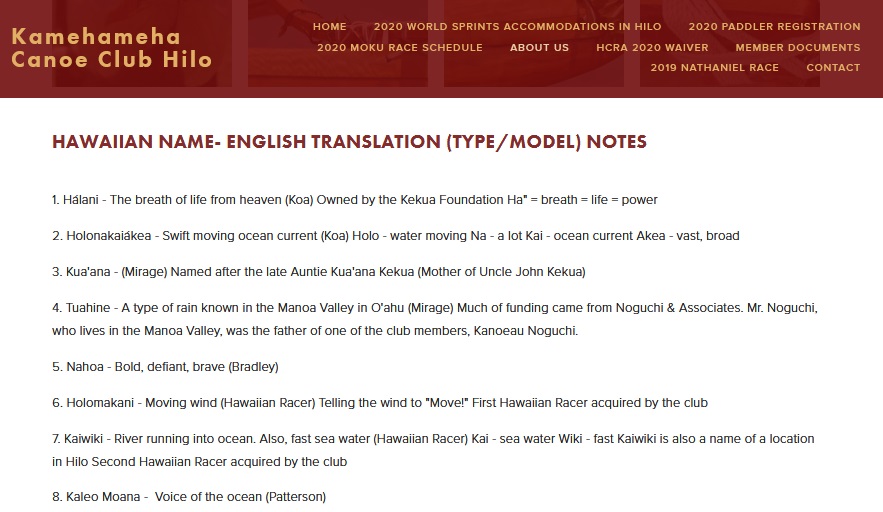
Force Marine in Hilo Hawaii has been manufacturing a range of boats from small personal fishing boats to large commercial catamarans since 1978. Sometime in the early 1980’s approximately 20 Force Marine (Jim) Patterson OC6s were manufactured and sold to various Hawaiian clubs including Hui O Mana Ka Pu‘uwai on Kauai (Eleu) and Kamehameha Canoe Club at Hilo (Kaleo Moana).
There are presently no Force Marine Patterson OC6s in Canada. There does not even appear to be a photo available of any of these OC6s.
[CH-07-Kaoloa]
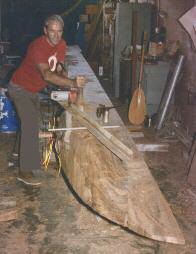
The OCC Board decided in 1981 that a new koa canoe should be built to complement two 80-plus year old koa canoes the Kakina and Leilani. The OCC Board commissioned member Joe Quigg to design a new koa canoe in March 1982. Laura Thompson of Hui Nalu Canoe Club in 1983 offered a koa log as a prize for the club that amassed the most points during the Oahu Hawaiian Canoe Racing Association’s regatta season. The OCC Board in 1985 commissioned Joe Quigg to design and build a canoe from this koa log that OCC won in 1983. Joe Quigg took on the challenge of shaping the 45-foot log that was extremely hard, heavy, and seriously rotted at both ends and the center as well. The ultimate result was a sleek, 44-foot 415-pound racing canoe named the Kaoloa, which means “long spear.” The new canoe was launched in 1986. The Kaoloa won the Molokai Hoe in 1990 setting a record along the way even beating the fiberglass canoes. It was the last koa canoe to achieve this distinction.
Return To Timeline[CH-08-Racer]
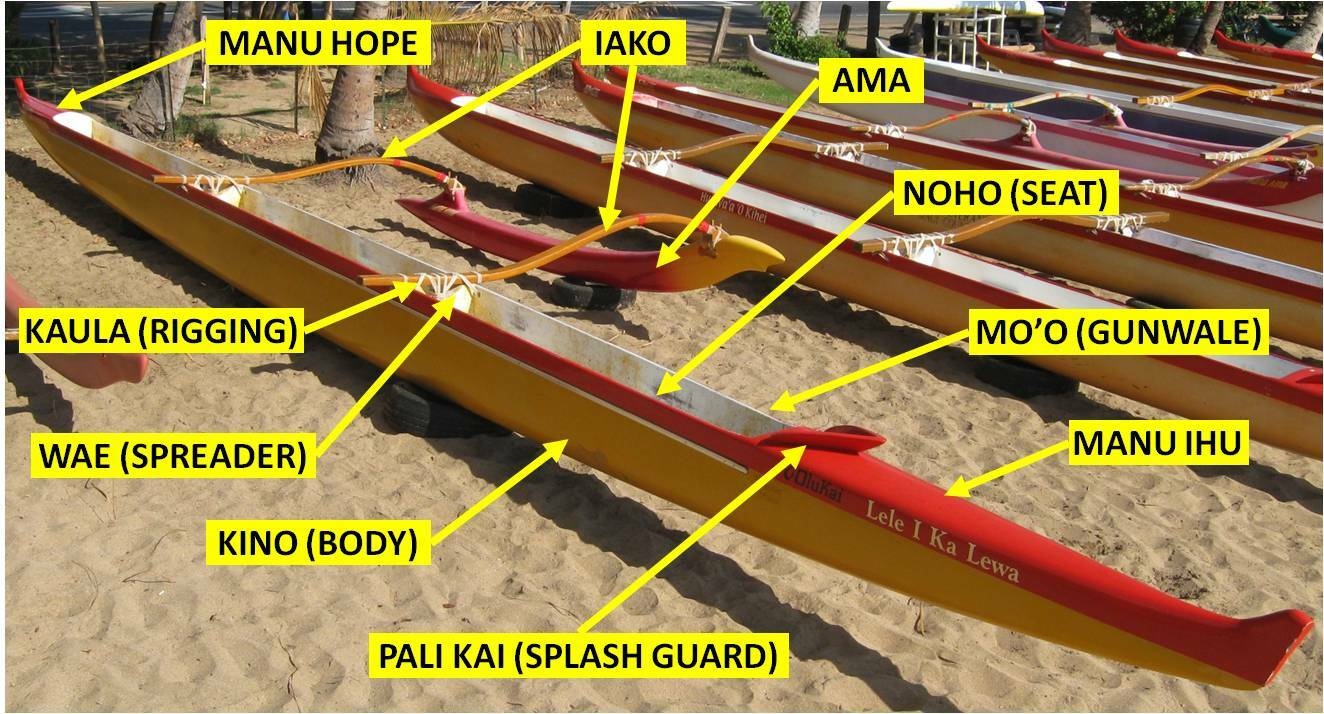
Sonny Kaukini Bradley became an apprentice in the late 1970’s to Tahiti’s master builder Puaaniho Taotaha. Melding Hawaiian and Tahitian traditions, Sonny began building canoes that continue to dominate the sport. The Bradley Racer was his first design to be manufactured on a commercial scale beginning in 1987. Two years later, at the Molokai Hoe, the Bradley Racer claimed seven of the top 10 places. Today the Bradley Racer is simply referred to as a Bradley and is the only make/model to race in SCORAs Bradley Division.
There are presently no Bradley Racer OC6s in Canada. The only known Bradley Racer in the Pacific NorthWest is presently owned by Hui Waa O Puget Sound (HWOPS) in Kenmore WA. The HWOPS club is very generous with their canoes and they have been kind enough to trailer their Bradley Racer (E Pili Mai) for CORA and PNWORCA paddlers to races at Alki Beach and Lake Washington.
[CH-09-Expo 86]

Please refer to the excellent article written by Doug Mancell of Lotus Sports Club that provides the most definitive written record of how outrigger canoe racing came to Canada. Tom Johnson kept the original Malia mould, the only mould available for outriggers in California, on his property in Lake Isabella, California until it was sold to the Head Coach of Lanakila Outrigger Club in 1974. The mould was used for several years to build canoes for clubs in Southern California, Northern California, and Hawaii. The Malia mould was then left unused for many years in a backyard in California. Several months after Expo ’86, David Boulding of False Creek Racing Canoe Club (FCRCC) had competed in the Catalina Channel Crossing and learned of a James Takeo Yamasaki Malia canoe mould somewhere in California. David Boulding arranged to have Mike Neckar of Necky Kayaks trailer the Malia mould up to Canada on his return trip after shipping kayaks to California. David Boulding arranged with Jim Mancell of Lotus Sports Club and Steve Schleicher of Nimbus Kayaks to make two outrigger canoes from this original Malia mould. The Malia mould was stored by Calmar Fiberglass until end of 2006. Mike Billy of North Van Canoe Club and CORA then intervened to store the Malia mould elsewhere to preserve its historical value.
There are presently 9 James Takeo Yamasaki Malia OC6s at 3 CORA clubs and 3 non-CORA Canadian clubs. The original 2 James Takeo Yamasaki Malia OC6s are presently at Pitt Meadows Paddling Club (PMPC).
[CH-10-HCR Canada]
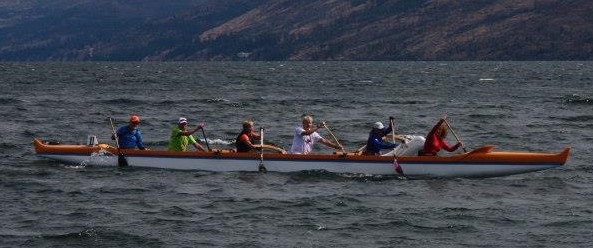
The Hawaiian Class Racer (HCR) in Canada is deserving of a chapter of its own. As noted in the chapter on the Hawaiian Class Racer (CCR), there are presently 2 Joe Quigg Hawaiian Class Racer (CCR) OC6s at 2 CORA clubs (Lotus; Penticton). The story of these 2 Joe Quigg Hawaiian Class Racer (CCR) OC6s is captured in an article on The First Outrigger Canoes In BC that can be found on the CORA website.
The Lotus Sports Club Hawaiian Class Racer (HCR) arrived in BC in 1988 and was moved to the Lotus Sports Club facility at Barnet Park in Burnaby soon after the club was established in 1988. There were a number of well-known BC names involved in this Hawaiian Class Racer (HCR) becoming part of the Lotus Sports Club fleet including David Boulding, Grace Morissette, Jim Mancell, Garry Mancell, Steve Schleicher, Bob Disbrow, and Milton K Wong.
The Penticton (PRCC) Hawaiian Class Racer (HCR) arrived in BC in 2000 when Don Mulhall played an integral part in an ongoing migration of canoes northwards from California. The 1992 Natoma IVF / IPCF (International Polynesian Canoe Federation) 5th World Sprints Championships resulted in the manufacture of a large number of IPCF OC6 hulls by the Northern California Outrigger Canoe Association (NCOCA). California teams would trailer older OC6s (Malias; Bradley Racers; IPCF ’92 hulls; Hawaiian Class Racers) to the Portland Race Around The Island (RATI) race one-way, sell them to PNWORCA clubs to help build up the Pacific NorthWest OC6 fleet, and then buy newer OC6s like the Bradley Striker and Force Five to upgrade the California OC6 fleet. Apparently, Penticton Racing Canoe Club had made a deal with a California club to have one of those canoes trailered to Portland OR and then onto Seattle WA, where Don Mulhall awaited with a trailer borrowed from Vernon Racing Canoe Club.
[CH-11-Wiliwili]
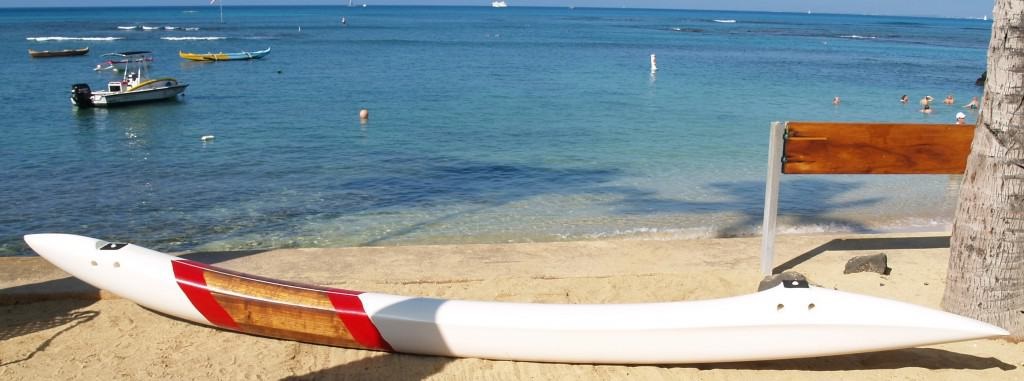
One of the most revolutionary changes in canoes and racing was the acceptance of a moulded ama circa 1989 referred to as the Channel Master. When Tommy Conner got involved with building the first newer designed boats in the late 1970s, he also designed some new ama that went with his boats. He shaped the ama out of foam to follow the concept of the shape of the boat so they got narrower, longer and more square-shaped on the bottom. OCC members (Jeff Kissell, Hank Lass, Bob Riley and Walter Guild) owned the Fiberglass Shop which manufactured fiberglass canoes. In the mid 1980s they commissioned OCC member Joe Quigg to shape an ama with his interpretation of what a modern ama should be along the lines of what Tommy Conner had started. HCRA eventually accepted this new ama design and now most canoe makers make much more durable, stronger and lighter moulded ama based on the Joe Quigg models.
Return To Timeline[CH-12-Calmar]
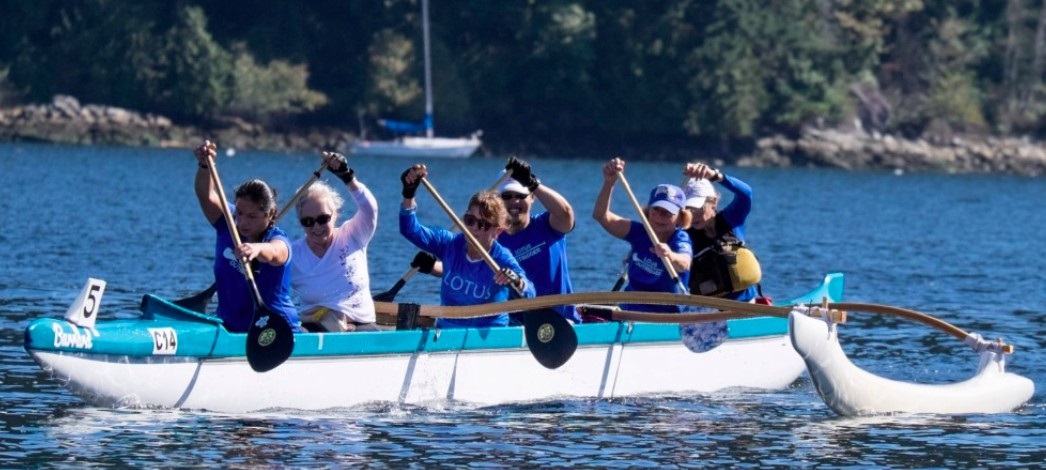
Ron Kaschula of Calmar Fiberglass may very well have been a contributor to one of the most pivotal episodes in the history of Pacific NorthWest outrigger canoeing. There is some literature as to how the Malia came to Canada and spawned outrigger canoe racing. There have been 2 Joe Quigg Hawaiian Class Racer (HCR) OC6s in Canada. David Boulding, Hugh Fisher, Don Irvine, and several others in the early 1990’s had input into designing a canoe to be manufactured by Ron Kaschula of Calmar Fiberglass that would increase paddlers’ safety in colder BC water. The length and width and shape of the Canadian Class Racer (CCR) OC6s were very similar to the Hawaiian Class Racer (CCR) OC6s, except that the bow of the Canadian Class Racer (CCR) was pointed and the gunwales were raised to support heavier crews. Calmar Fiberglass apparently approached PNWORCA in 1996 / 1997 and offered to mass produce the Calmar Canadian Class Racer (CCR) for PNWORCA clubs.
There are presently 30 Calmar Canadian Class Racer (CCR) OC6s at 14 CORA clubs and 2 non-CORA Canadian clubs making this the most prevalent OC6 in Canada. There are at least another 30 Calmar Canadian Class Racer (CCR) OC6s owned by Washington / Oregon PNWORCA clubs making this the most prevalent OC6 in the Pacific NorthWest.
[CH-13-Pacific Islander]
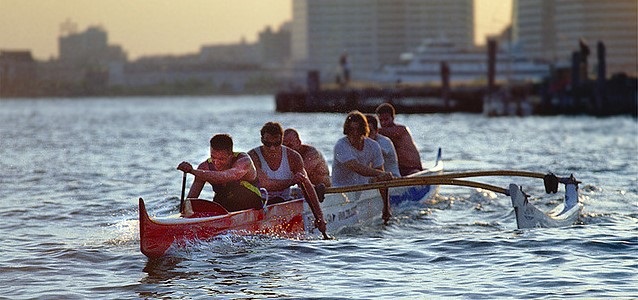
Dennis Campbell of Imua Outrigger Club started production of his third fiberglass canoe, the Pacific Islander in 1991. There is a red / white / blue Pacific Islander Class OC6 (with a Huki OC6 ama) at New York Outrigger (Haulani) that was acquired from Haul ani Imua Outrigger Canoe Club of Newport Beach CA. There are a few Pacific Islander Class OC6s still in use in Southern California such as the Teiva with Kapolioka’ehuka Outrigger Canoe Club in San Diego CA. “As a side note, the mould for the canoe was sold to Brazil and helped to start outrigger manufacturing in South America.”
There are presently no Dennis Campbell Pacific Islander OC6s in Canada. The only known Dennis Campbell Pacific Islander in the Pacific NorthWest is presently owned by Hood River Outrigger Canoe Club (HROCC) in Hood River OR.
[CH-14-IPCF OC6 hull]
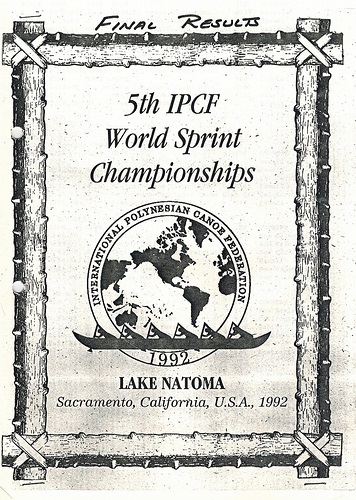
The International Polynesian Canoe Federation (IPCF) mandated that race organizers would provide a fleet of OC6 hulls with a newly adopted standard of mostly Tahitian character as of the New Zealand 4th IPCF / IVF 1990 World Sprints Championships. Edward Maamaatua of Pirae Canoe Club in Tahiti, who had been given several K1 and C1 Olympic boats by the French national canoe team, has been credited with the design of the IPCF OC6 hull. The Natoma 5th IPCF / IVF 1992 (International Polynesian Canoe Federation) World Sprints Championships resulted in the manufacture of a large number of IPCF OC6 hulls by the Northern California Outrigger Canoe Association (NCOCA). Don Irvine and Hugh Fisher, representing Canada, would place 2nd and 3rd in the V1 Open Men’s Final, the best placing to this day for Canada in the V1 Open Men’s division.
There are presently no IPCF 1992 OC6s in Canada. The only known IPCF 1992 OC6 (“Weird Eddy”) in the Pacific NorthWest is presently owned by Columbia River Outrigger Canoe Club (CROCC) in Portland OR.
[CH-15-Force Five]
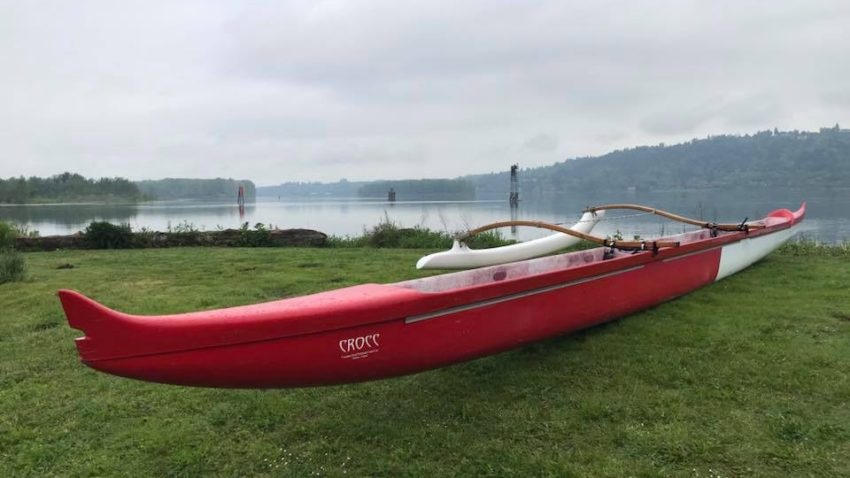
The Walter Guild Brent Bixler Force Five was introduced in 1995 based on the Hawaiian Class Racer (HCR). The Hawaiian Class Racer (HCR) was widened 1-2 inches to give it more volume, the rocker was lengthened to midship, and the bow was changed to make for a more efficient entry to become a competitive successful boat for six-man Molokai racing. The Walter Guild Force Five is 40-45 feet long and can be identified by a notch in the back manu hope. The Walter Guild Force Five is common in Australia as it was the canoe selected for the 2000 Townsville Australia IVF World Sprints. Walter Guild and fellow Outrigger Canoe Club (OCC) members, Bob Riley, Hank Lass, and Jeff Kissel had acquired The Fiberglass Shop in Campbell Industrial Park in 1980 from Bob Kreps when he was leaving the business, and produced countless canoes until shutting down manufacturing in 2000. Walter Guild formed Canoe Sports Hawaii in 1989 to combine canoe manufacturing with promotion of canoe racing. The Walter Guild Force Five is also found in Hawaii, California, and the Eastern US.
There are presently 4 Walter Guild Force Five canoes in eastern Canada at 1 CORA club (Thunder Bay) and 2 non-CORA Canadian clubs (Wai Nui; Pickering Rouge). The only known Walter Guild Force Five in the Pacific NorthWest is presently owned by Columbia River Outrigger Canoe Club (CROCC) in Portland OR.
[CH-16-Encore]
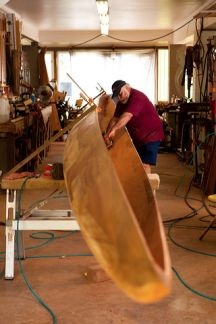
The Bradley Encore was modified from the Bradley Racer in 1996 with lower gunwales for high school regattas. The lower gunwales make it user friendly for women and various men divisions as it is much easier to get over into the hull as changes are being made. Bradley Encores are owned by various Hawaii clubs as per the Hawaii Canoe Racing Association (HCRA) Canoe Registry.
There are presently no Bradley Encores OC6s in Canada.
[CH-17-Advantage]
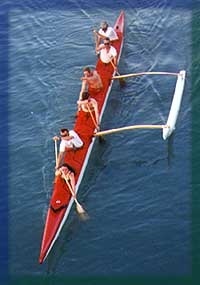
Olympic Gold Medal Winner and Epic Kayaks Designer Greg Barton collaborated with Western Canoeing and Kayaking on the production of a six person Hawaiian racing outrigger in 1996. The Clipper Advantage OC6 was designed to meet Hawaiian Outrigger Specifications using either the Hawaiian or California test methods. The Clipper Advantage OC6 was designed specifically to perform in moderate seas as opposed to huge open ocean waves. In April 1998 a production canoe was certified race legal by KOA (Kalifornia Outrigger Association) standards. Greg Barton raced the Clipper Advantage OC6 to a first place in the Men’s Masters division at Catalina 1998 with Team Hawaii Masters steered by “Nappy” Napoleon.
There are presently 30 Clipper Advantage OC6s at 17 CORA clubs making this the second most prevalent OC6 in Canada. With the Calmar Canadian Class Racer (CCR) and the Bradley Lightning no longer being manufactured in Canada, it may be just a matter of time before the Clipper Advantage becomes the most prevalent OC6 in Canada.
[CH-18-North Beach]

James Van Nostrand of Clipper Canoes was one of the most prominent and reputable recreational canoe and outrigger canoe and kayak designers in Canada. In addition to the Clipper Advantage OC6, James was also responsible for the resurgence of the C-Lion OC1 and the Clipper North Beach OC4.
There are presently 9 Clipper North Beach OC4s at 5 CORA clubs (Gibson’s; Nanaimo Ocean Paddling; False Creek; Prince Rupert; Sproat Lake) and there maybe others in use belonging to other than CORA clubs.
[CH-19-Fiji IVF]

It is likely that the Fijian Rotuman Tafaga long canoes had been in existence for centuries before Rotuma was reconnoitred in 1791 by Captain Edwards in HMS Pandora while he was searching for the Bounty mutineers. It seems appropriate that 2 of the 6 presently active canoe clubs in Fiji are named after the one-person canoe (Takia OCC) and the six-person canoe (Tafaga OCC) used in the 1998 Fiji IVF World Sprints.
There are presently 2 Vakaloloma Fijian (Tafaga) OC6s at a single CORA club (Gibson’s). Sometime after the 1998 Suva Fiji 8th International Polynesian Canoe Federation (IPCF) World Sprints, Ron Dickinson of Spirit of Aloha Racing (SOAR) on the Sunshine Coast acquired 2 Vakaloloma Fijian (Tafaga) OC6s each weighing 230lbs that had been shipped in a container to the West Coast. Gibson’s acquired the 2 Vakaloloma Fijian (Tafaga) OC6s in 2013 when Spirit of Aloha Racing (SOAR) folded.
[CH-20-Striker]
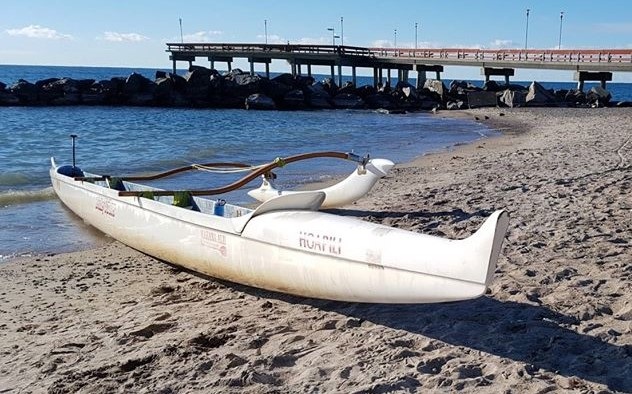
Sonny Kaukini Bradley produced his first fiberglass canoe, the Bradley Racer in 1987. With an expanded fiberglass shop in 1999, the Bradley Striker came next. The Bradley Striker and the Outrigger Connection Mirage would dominate the Molokai Hoe from 1999-2008 until the emergence of the Bradley Lightning. Calvin Hirahara of Marina Del Rey Outrigger Canoe Club built Bradley Strikers for West Coast clubs with moulds supplied under the direction of Sonny Bradley.
There is presently only 1 Bradley Striker at a single CORA club (Toronto Sailing Canoe Club Maka Koa) making this one of the rarest OC6s in Canada.
[CH-21-Mirage]
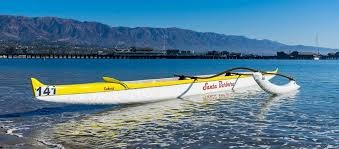
Karel Tresnak of Outrigger Connection began to successfully manufacture OC1s in 1993. The first prototype of the Outrigger Connection Mirage OC6 was introduced in 1997. The second prototype of the Outrigger Connection Mirage OC6 finished first and second in the 2000 Molokai Hoe with Lanikai setting a new event record. The Outrigger Connection Mirage OC6 introduced the “Puffy” ama and performs excellent in the flat conditions. Outrigger Connection opened its first franchise in 2002 with Current Designs in Victoria BC and then its second franchise in 2003 with Outrigger Connection Australia.
There are presently 21 Outrigger Connection Mirage OC6s at 14 CORA clubs making this the fourth most prevalent OC6 in Canada.
[CH-22-Huki]
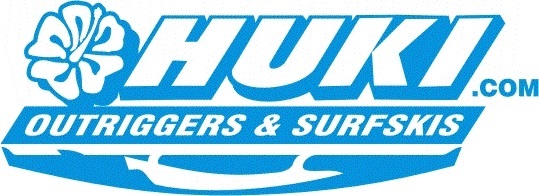
Jude Turczynski of Huki has been building one-person two-person outrigger canoes and surfskis in Sacramento CA since 2003. One product that you will not find on the Huki website is the Huki OC6 ama. There is material on the web regarding Malia, Channel Master, Puffy, Calmar, Advantage, Bixler, and Bradley amas used on OC6s across Canada, but only occasional references to the Huki OC6 ama. We inquired of Jude Turczynski as to the history of the Huki OC6 ama. Apparently, several years before Huki began manufacturing outrigger canoes and surfskis, the Huki OC6 ama was a prototype that provided insight for the design of small boats and cash flow to finance the manufacture of outrigger canoes and surfskis.
There are presently several CORA clubs (Delta; Gibson’s; Kelowna; Vernon) that have this Huki OC6 ama with the distinctive “tomahawk” sharp front edge.
[CH-23-Lightning]
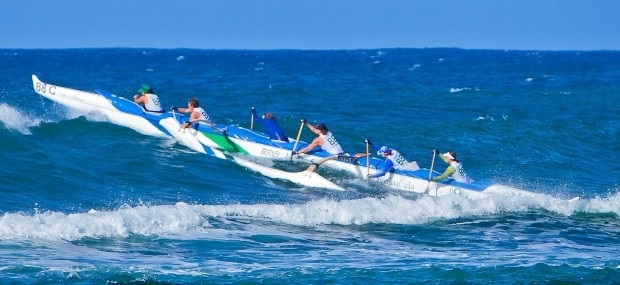
Sonny Kaukini Bradley rolled out his masterpiece, the Bradley Lightning, in 2005. The Bradley Lightning or Bradley Striker or Bradley Racer would finish first place in the Molokai Hoe from 2006-2014. It should be noted that there have been at least 3 different manufacturers of the Bradley Lightning. Karel Tresnak of Karel’s Fiberglass Products Inc built Bradley Lightnings for Hawaii clubs. Calvin Hirahara of Marina Del Rey Outrigger Canoe Club built Bradley Lightnings for West Coast clubs with moulds supplied under the direction of Sonny Kaukini Bradley. Ryan Pogue of Pogue Sports built lighter Bradley Lightnings for Pacific NorthWest and California clubs.
There are presently 28 Bradley Lightning OC6s at 13 CORA clubs and 4 non-CORA Canadian clubs making this the third most prevalent OC6 in Canada. Now with only Halau Outrigger Canoa Havaiana in Brazil manufacturing a 3-piece Bradley Lightning, any additional Bradley Lightnings in Canada will need to be imported.
[CH-24-M2]
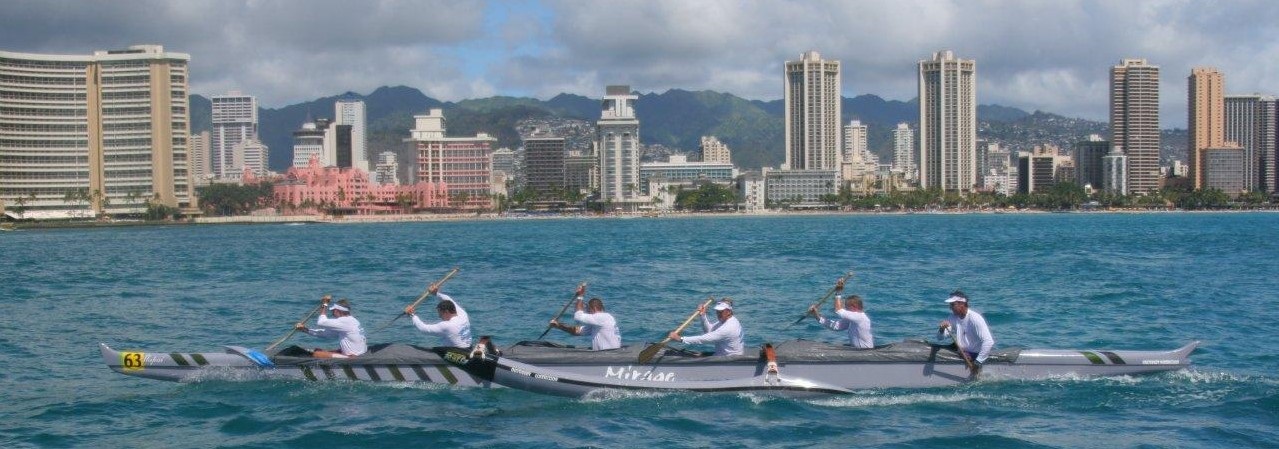
The Outrigger Connection M2 Mirage was designed in 2008 by the Outrigger Connection Team and utilizes the same “Puffy” ama as the Outrigger Connection Mirage OC6. The Outrigger Connection Mirage OC6 was designed to take advantage of the additional buoyancy of saltier waters. The increased hull width and more pronounced calabash in the centre of the canoe allows the canoe to accelerate faster, turn quicker, and pick-up waves a lot easier.
There is presently only 1 Outrigger Connection M2 Mirage at a single CORA club (False Creek) making this one of the rarest OC6s in Canada.
[CH-25-Kamanu]

Kamanu Composites was founded in 2007. The company is centered out of Kailua HI, but has licensed local manufacturers in France (Woo) and Australia (Kamanu AUS) and distribution networks in Los Angeles, Seattle, Japan, and Hong Kong. Kamanu has been building Unlimited OC6s since 2010 including the Nanahope (205lbs) and the Elepaio (190lbs).
There are presently 2 Woo Kamanu OC6s at a single CORA club (H2O Outrigger) and a single non-CORA Canadian club (Wai Nui). There is also 1 Woo Da Kai OC4 at a single CORA club (Squamish). These Eastern Canada clubs have imported Kamanu OC6s from the France manufacturer due to the challenges of obtaining canoes from Hawaii manufacturers.
[CH-26-Noumea IVF]
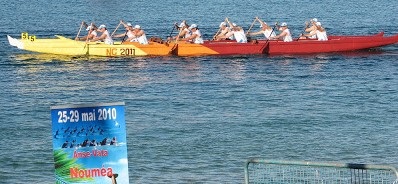
Pogue Sports in Vancouver BC produced approximately 18 Bradley Lightnings under a license from Sonny Kaukini Bradley between 2009-2010 that were commissioned for the 2010 New Caledonia IVF World Sprints. All of the Noumea Bradley Lightnings had an identical tri-colour (yellow / orange / red) scheme. Apparently, the 16 Noumea Bradley Lightnings were too long for the shipping containers so they had to be cut to fit and then put back together once they arrived in New Caledonia. There was not enough time after the canoes were put back together to finish the insides and so paddlers were all rubbed raw at the knees with fiberglass rash. The paddlers got very creative cutting up socks to wear around their knees. Pogue Sports kept two of the Noumea Bradley Lightnings and these were sold to Vancouver Ocean Sports (VOS). One of the VOS Bradley Lightnings (“Jazz”) was sold to Fort Langley Canoe Club in 2011 and the other VOS Bradley Lightning (“Elmo”) was sold to Dragon Zone Paddling Club in 2012.
Return To Timeline[CH-27-Calgary IVF]
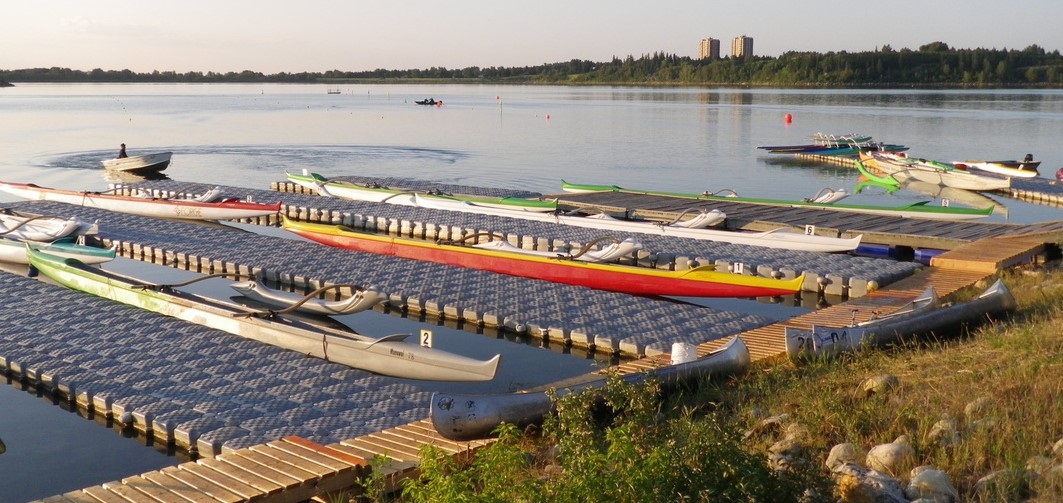
Pogue Sports in Vancouver BC produced 30-40 Bradley Lightnings under a license from Sonny Kaukini Bradley that were delivered to West Coast clubs from 2009-2013. CORA commissioned Pogue Sports to produce 14 lighter (330-340lbs) Bradley Lightnings for the 2012 Calgary IVF World Sprints. Most of the Bradley Lightnings were pre-sold to clubs in Alberta, BC, Washington, and Oregon under the premise that the canoes would be delivered to the clubs after the conclusion of the color: red 2012 Calgary IVF World Sprints. There is a mention that the Bradley Lightning does not have a bell-shaped hull design. Only the Pogue Sports Bradley Lightnings lack this calabash or bell-shape. The Pogue Sports Bradley Lightnings were manufactured specifically for Pacific NorthWest conditions (lakes; rivers; light ocean surf).
Return To Timeline[CH-28-Matahina]
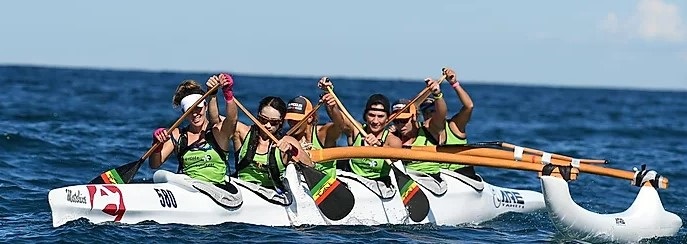
The ARE Matahina was first raced in Tahiti in October 2012 and then dominated the Hawaiki Nui Va’a in November 2012. The Tahitian ARE Matahina Unlimited OC6 at 130 Kilos (280lbs) is much heavier than the Hawaiian Unlimited OC6s (145lbs). ARE Va’a Australia in Mooloolaba QLD is the Australian distributor for the ARE Matahina. Newport Outrigger Canoe Club acquired the first ARE Matahina on the mainland United States. That canoe was borrowed by Team Air Tahiti, who finished 1st overall in its maiden race, the 2018 US Outrigger Championship’s Catalina Crossing.
There is presently only 1 ARE Matahina (privately owned) stored at a single CORA club (Lotus). Kenneth Ang collaborated with Will Reichenstein to introduce Canadian paddlers to the ARE Matahina. Will Reichenstein of the Wa’a House trailered the Newport Outrigger Canoe Club ARE Matahina “Aukuso Fuiaavailili” to Canada for Canadian clubs to try out resulting in several Lotus Sports Club members making a private purchase of this canoe. The ARE Matahina canoes come in two weight classes – Club Model @ 110 kgs (240 lbs) and Performance Model @ 95 kgs (210 lbs). There is a container of ARE Matahina V6s expected to be shipped directly to the Port of Vancouver in the Winter of 2020 / 2021.
The only other known ARE Matahina in the Pacific NorthWest is presently owned by Kikaha in Tacoma WA. Team Air Tahiti borrowed the Kikaha ARE Matahina for the 2019 Gorge Race and took 10 minutes off the course record set in 2018 by Red Bull Wa’a.
[CH-29-Vortex]
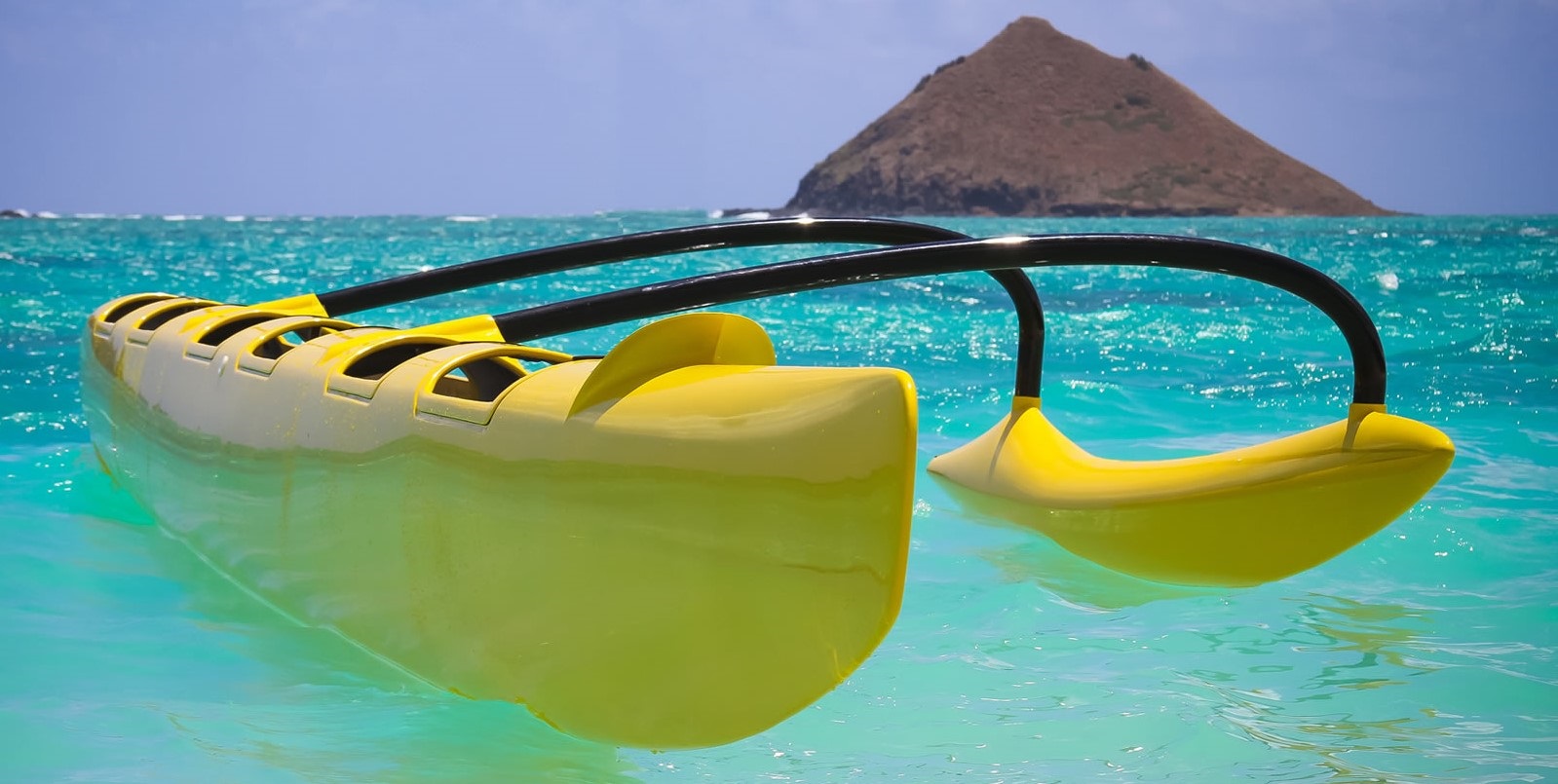
Ozone (Outrigger Zone) in Maui HI has been manufacturing canoes and products designed by Kai Wa’a, Puakea Designs, and Mike Giblin for over 25 years including the new Unlimited Puakea Malolo and Giblin Vortex OC6 canoes. Mike Giblin manufactured the Kaumuali’I out of an old workshop on Maui as an Unlimited OC6 prototype for the 2012 Olamau Race. Kai Aniani Canoe Club of Florida in September 2013 were one of the first outrigger clubs to take ownership of the new Giblin Vortex. Outrigger Zone has dealers in territories worldwide. JD Davies of Waterwalker in Carson WA has been selling canoes and surfskis in the Pacific NorthWest since 1994, and has been organizing the largest canoe race in the Pacific NorthWest for over 20 years, the Gorge Outrigger Canoe Race. As an Ozone distributor and manager of the Ozone Pacific NorthWest warehouse, JD Davies hosted an open house in July 2014 with Mike Giblin at the Gorge Outrigger Canoe Race with his new Vortex Unlimited OC6. There were no takers. In the summer of 2015, Lance Mamiya of Kennewick WA became the first owner of a Vortex Unlimited OC6 in PNWORCA and formed Team FreeLance.
There are presently 10 Giblin Vortex OC6s at 8 CORA clubs.
[CH-30-Malolo]
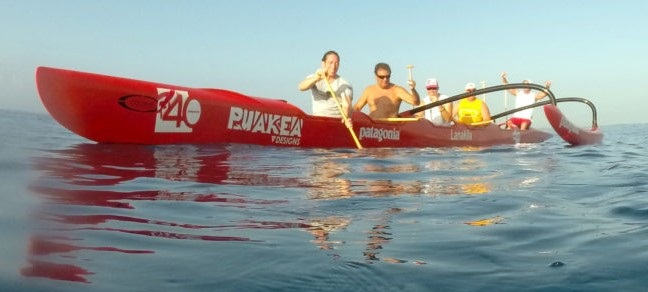
The (Johnny) Puakea Designs Unlimited Malolo (145lbs) is a refined design of the 2013 Olamau Race Shell Va’a winning canoe, the canoe that was built specifically using the Outrigger Zone (Ozone) one-piece construction. Outrigger Zone builds singles (OC1), doubles (OC2) and six-person outrigger canoes (OC6). Hana Hou Paddlesports (HHP) in Comox Valley BC owned by Don Irvine and Zoe Norcross-Nu’u has been the western Canada distributor for Outrigger Zone (Ozone) since 2013. ColdWater Canoe in Ottawa ON owned by Trevor Woodside has been the eastern Canada distributor for Outrigger Zone (Ozone) since 2017.
There are presently 11 Puakea Malolo OC6s at 8 CORA clubs and 2 non-CORA Canadian clubs.
[CH-31-Vantage]
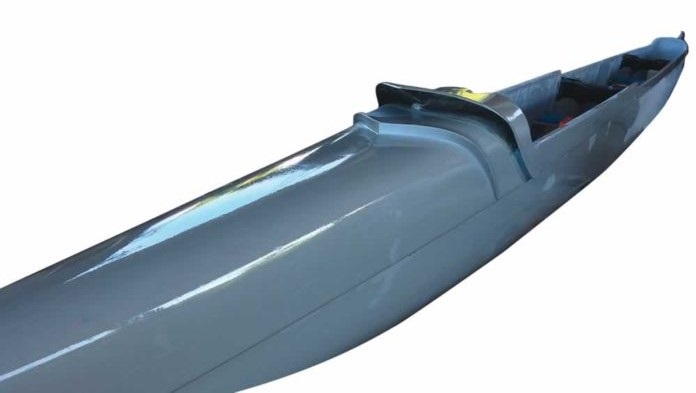
The IHE Vantage 6 canoe was introduced in 2017 by Steve Blyth given the need for another legal spec canoe with Karel Tresnak of Outrigger Connection retiring. The 400lb OC6 was designed to perform at a higher level in smaller conditions such as 4-foot and under. The IHE Vantage 6 will be manufactured in Hilo HI by Frank Haug who was with Force Marine for 25 years when they were building the Patterson OC6 canoe. IHE Vantage 6s are owned by various Hawaii clubs. The Hawaii Canoe Racing Association (HCRA) Canoe Registry. is a few years out-of-date and does not yet show IHE Vantage 6 owners.
There are presently no IHE Vantage OC6s in Canada.